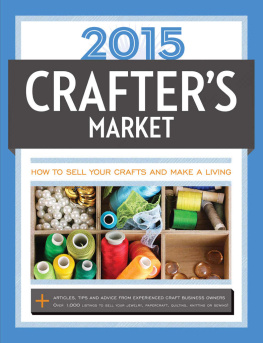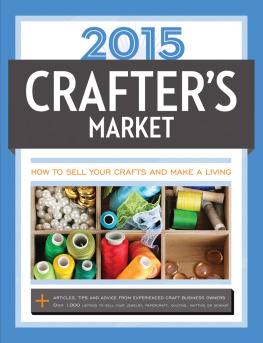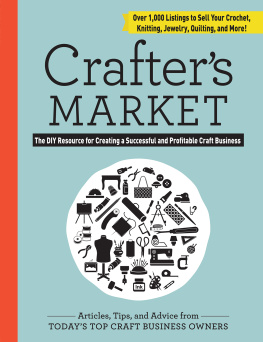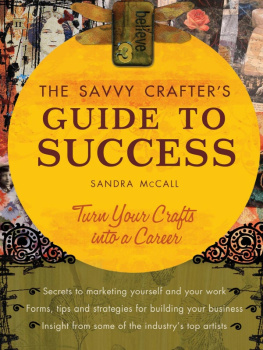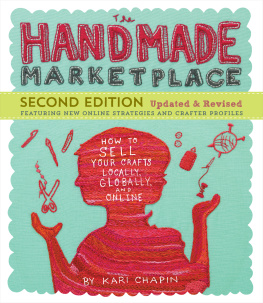1ST ANNUAL EDITION
2015
CRAFTERS
MARKET
HOW TO SELL YOUR CRAFTS AND MAKE A LIVING
Kelly M. Biscopink, Editor

Cincinnati, Ohio
CONTENTS

Tonia Jenny

Lindsay Wilkes

Elizabeth Maxson
FROM THE EDITOR

Photo by Leslie McKella
Craft is such a little word, but it includes an enormous amount and variety of work. From traditional needlework and quilting to modern crochet and scrapbooking and everything in between, crafting is an art form, and those that do it are true artisans. Creating handmade, one-of-a-kind items is at once gratifying and inspiring, and keeps craft artisans constantly pushing toward achieving new success.
With the help of certain websites like Etsy, Ravelry, Craftsy, ArtFire and others, as well as social media, it is easier than ever for crafters to sell their handmade products from the comfort of their own home. For those crafters who want to turn their passion into their business, this book is both a starting point and a research tool. A section of articles from crafty professionals provides insight, tips and advice into business-related subjects such as branding, packaging, social media, publishing and copyright. This shrewd business advice is sprinkled with personal stories from the front lines of craft business ownership. The writers featured in this first edition of Crafters Market are thrilled to help up-and-coming craft professionals start, build and grow their business, and their advice will certainly help new business owners avoid some common mistakes.
The bulk of the book is filled with listingsnames, contact information, company descriptions, submission guidelines and morefrom companies and events that provide avenues for building and growing a craft business. These listings are broken down into the following categories: Book Publishers, Craft Magazines, Industry Shows, Craft Communities, and Craft Fairs and Online Marketplaces. You can use these listings to expand your business into new arenas, and to discover opportunities you may not have known existed.
Happy crafting!
Kelly M. Biscopink
HOW TO USE THIS BOOK
If youre picking up this book for the first time, you might not know quite how to start using it. Your first impulse might be to flip through and quickly make a mailing list, submitting your work to everyone with hopes that someone might like it. Resist that urge. First you have to narrow down the names in this book to those who need your particular style. Thats what this book is all about. We provide the names and addresses of places to sell your handmade creations and publish how-to instructions, along with plenty of business advice. You provide the hard work, creativity, and dedication to making and selling handmade goods.
Listings
The book is divided into market sections, from craft fairs to publishers. (See the Table of Contents for a complete list.) Each section begins with an introduction containing information and advice to help you break into that specific market. Listings are the meat of this book. In a nutshell, listings are names, addresses, and contact information for avenues through which you can sell your craft and hone your business.
Articles and Interviews
In this book, you will find helpful articles and interviews with working crafters, editors and experts from the craft world. These articles give you a richer understanding of the marketplace by sharing the featured artists personal experiences and insights. Their stories, and the lessons you can learn from other crafters feats and follies, give you an important edge over competition.
How Crafters Market Works
We suggest you follow the instructions in the listings and explore the different methods and avenues you can use to successfully sell your handmade goods. Whether your interest lies in publishing, craft fairs or growing your online presence, you will find instructions in the listing on how to reach out to the correct people.
Working With Listings
1. Read the entire listing to decide whether that publisher, craft fair or website is a good fit. Do not use this book simply as a mailing list of names and addresses. Reading listings carefully helps you narrow your list to select the most appropriate places to sell your work.
2. Read the description of the company in the first paragraph of the listing. Then jump to the Needs or Media heading to find out what type of artwork is preferred. Is it the type of craft you create? This is the first step to narrowing your target market. Only consider working with those places that need the kind of work you create.
3. Send appropriate submissions. It seems like common sense to research what kind of samples a listing wants before sending off just any artwork you have on hand. But believe it or not, some artists skip this step. Look under the First Contact & Terms heading to find out how to contact the market and what to send. Some companies and publishers are very picky about what kinds of samples they like to see; others are more flexible. Failure to follow directions in submissions may result in automatic rejection from a publisher or show.
4. Be sure to read the Tips. This is where editors and directors describe their pet peeves and give clues for how to impress them. The information within the Tips will help you get a feel for what a publisher might be like to work with or a show might be like to attend.
These steps are just the beginning. As you become accustomed to reading listings, you will think of more ways to mine this book for potential craft outlets.
Pay Attention to Copyright Information
If you are using this book to locate a publisher or find a magazine to work with, its important to consider what rights publishing companies buy. It is preferable to work with companies that buy first or one-time rights. If you see a listing that buys all rights, be aware you may be giving up the right to sell that particular craft in the future. See the Copyright Basics article in this section for more information.

